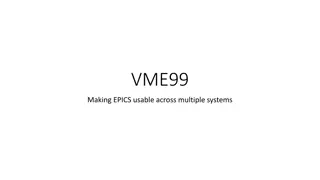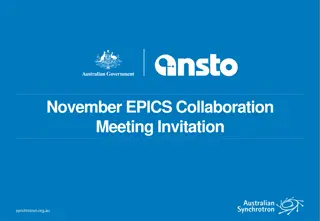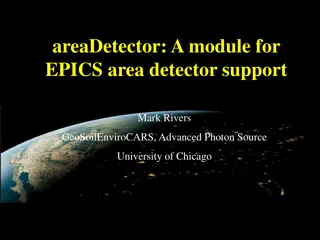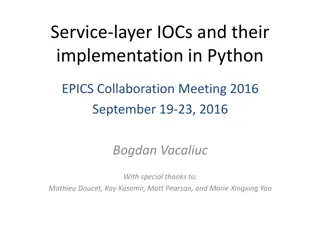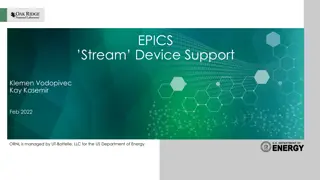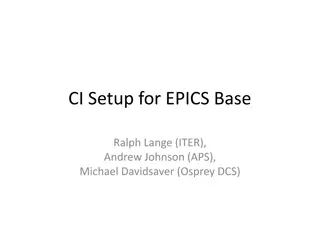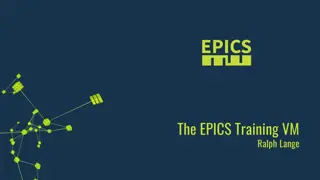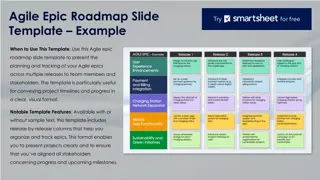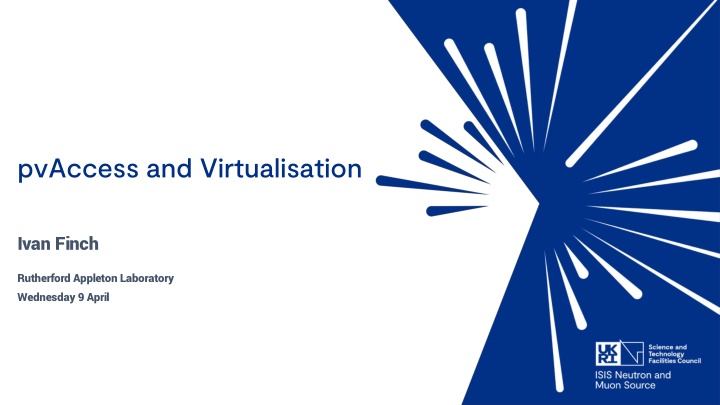
pvAccess and Network Communication Analogy
Explore the concepts of pvAccess, UDP, TCP in network communication through engaging postal analogies. Learn about UDP broadcast limitations, network boundaries, and how pvAccess uses UDP broadcast, UDP unicast, and TCP for information exchange.
Download Presentation

Please find below an Image/Link to download the presentation.
The content on the website is provided AS IS for your information and personal use only. It may not be sold, licensed, or shared on other websites without obtaining consent from the author. If you encounter any issues during the download, it is possible that the publisher has removed the file from their server.
You are allowed to download the files provided on this website for personal or commercial use, subject to the condition that they are used lawfully. All files are the property of their respective owners.
The content on the website is provided AS IS for your information and personal use only. It may not be sold, licensed, or shared on other websites without obtaining consent from the author.
E N D
Presentation Transcript
pvAccess and Virtualisation Ivan Finch Rutherford Appleton Laboratory Wednesday 9 April
UDP Postal Analogy UDP is like a postcard. We send if off to an (IP) address and receive no notification about whether it was received.
TCP Postal Analogy TCP is like a postcard. Except that our recipient always writes back to tell us whether they received the message and whether any parts of it were missing.
Routing Postal Analogy Post doesn't just teleport! We can imagine our postcard from a post box in Oak Ridge goes to the local sorting office, then onto a US Post international sorting office (in Atlanta?), a plane to a Royal Mail international sorting office in London, then to a local sorting office in Oxford, and then to my colleagues. This also works a lot like a simple model of the internet!
UDP Broadcast Postal Analogy Imagine we send a postcard to our sorting office, and it sends a copy to every address it serves this is roughly how UDP Broadcast works. An important limitation is that it will only be sent to local addresses. Even though we know our sorting office can send messages to England we can't get these broadcast messages to there.
Network Boundaries We are often in a situation where two devices (servers, clients, IOCs, etc.) can talk to each other via TCP and UDP unicast but because of network boundaries cannot talk to each other via UDP Broadcast. Network Boundary TCP UDP Unicast Device 1 Device 2 In our postal analogy, postcards may be sent between the two devices, but they are served by different sorting offices. UDP Broadcast
pvAccess pvAccess uses a combination of UDP Broadcast (or Multicast), UDP unicast, and TCP Default ports are 5075/TCP and 5076/UDP The basic pattern is that when a client wants to know if a server (IOC) has a PV it sends out a search message as a UDP Broadcast on the local network. If any server has the PV it replies via UDP unicast and the systems establish a TCP connection to exchange further information.
What's the Problem? Using pvAccess in combination with containers: Everything works as expected within the same container Everything works between containers. If they're on the same machine and container network typical for development UDP broadcasts can't cross into to from the container network, e.g. on Windows or with podman on Linux. Symptom: Phoebus on the local machine cannot see PVs inside a container on the same machine. (This can also be useful for development!) Container orchestration, such as Docker Swarm or Kubernetes can add additional challenges. For example, UDP broadcasts cannot cross between nodes in a Docker Swarm setup, even if they are in the same container network. Together these make it hard to develop pvAccess with containers and makes normal redundancy schemes difficult to implement on container orchestration systems.
What's the Solution? EPICS_PVA_NAME_SERVERS In some cases, there is an easy way around this limitation. The environment variable EPICS_PVA_NAME_SERVERS allows us to bypass the UDP broadcast search and UDP unicast search reply. Instead, we can set the EPICS_PVA_NAME_SERVERS environment variable to point directly at the IP address of the required server if we know it. Communication will then happen via TCP only. e.g. EPIC_PVA_NAME_SERVERS=example.server.ac.uk:7075 EPICS_PVA_NAME_SERVERS is supported in: pvxs C++ library for pvAccess p4p Python library for pvAccess (built on pvxs) Phoebus
What's the Problem? EPICS_PVA_NAME_SERVERS IOCs must use a version of EPICS base that supports pvxs and build it. As we are bypassing search, we must set the IP address of every IOC / container in advance. If we are running multiple IOCs in a container-based environment, then we must allocate each a different port and include it as an extra entry in the EPICS_PVA_NAME_SERVERS setting Container IOC1 opens port 7075, container IOC2 opens port 7076, etc. EPIC_PVA_NAME_SERVERS=example.server.ac.uk:7075 example.server.ac.uk:7076 Note: EPICS_PVA_NAME_SERVERS reveals an important security implication. It is possible to believe that IOCs cannot be controlled from outside the local network when this is the case. This may be addressed with standard network tools (firewalls, isolated networks) or at the IOC level (ACL files).
What's the Solution? PVA Gateway There is an existing solution for making pvAccess PVs available across network boundaries: PVA Gateway PVA Gateway has a client side and a server side, which may be on different networks, and allows connections to bridge between these two networks. A useful trick for docker is that we can target the default bridge network as the server side. This allows a gateway on bare metal to see containers on the same node. PVA Gateway is part of p4p, written by Michael Davidsaver. https://epics-base.github.io/p4p Images from PVA Gateway documentation
What's the Problem? PVA Gateways If running inside the container environment, the PVA Gateway still needs to be able to see the UDP Broadcasts. Use host networking on Linux but not Windows. However, even on Linux this is not compatible with the overlay network used by Docker Swarm. Expose the TCP port and use EPICS_PVA_NAME_SERVERS. We cannot use UDP searches but we can access any IOCs, etc. running in the container environment. Docker only: run the PVA Gateway on bare metal and use the docker bridge network as the server side. Exposes all containers on that node, but only that node. Potential general solution: run one PVA Gateway on bare metal, run a second in the container environment, set them to talk to each other via TCP-only. Suggest setting a non-standard port for the PVA Gateway in the container environment
PVA Gateways on a Docker Swarm at ISIS Node 1 Node 2 Node 3 PV Bare Metal PVA Gateway Bare Metal PVA Gateway Bare Metal PVA Gateway Get
Docker Swarm Another UDP Broadcast Problem! Node 1 Node 2 Node 3 PV Client Docker Swarm is Docker s rough equivalent of Kubernetes a way of orchestrating containers across multiple systems. It uses the same basic configuration as the familiar Docker Compose files and offers robust failover. If a node leaves the swarm its containers migrate to other available nodes. Docker networks are transparent across nodes in the Swarm. However, this is not true for UDP broadcast. It is not possible to search for PVs on other nodes in the swarm.
SnowSignal on Docker Swarm Node 1 Node 2 Node 3 Relay Relay Relay PV Client Bare Metal PVA Gateway Bare Metal PVA Gateway Bare Metal PVA Gateway Get
Relaying UDP Broadcast Messages Back to the postal analogy one last time. We want pvAccess Search messages to cross between defined network boundaries. We can do this by establishing a relay system. Relay We have an agent that receives UDP broadcasts from one sorting office and forwards them on by conventional UDP to another agent at a different sorting office. The second agent then performs a UDP broadcast, acting as a relay. Relay
SnowSignal https://github.com/ISISNeutronMuon/SnowSignal
SnowSignal compared to PVAGateway SnowSignal PVAGateway Allows pvAccess UDP broadcast search and beacon messages to cross network boundaries via UDP & TCP unicast Allows pvAccess across independent networks Allows filtering by PV name Allows authentication and authorisation Allows use of alternate ports to standard ports





